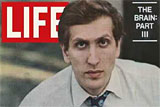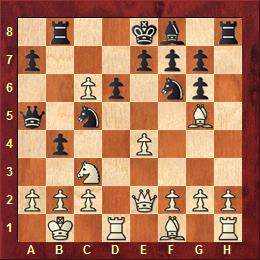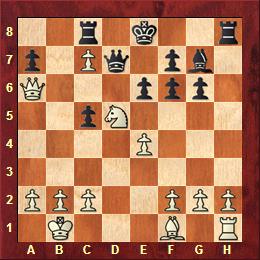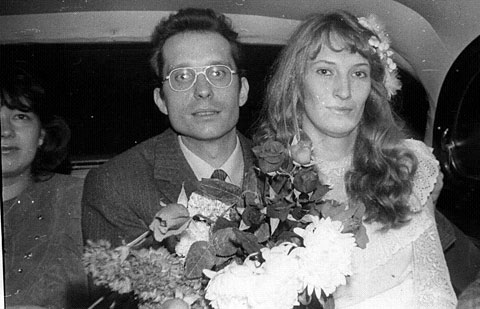



Robert James "Bobby" Fischer was an American chess grandmaster and the 11th World Chess Champion. He is considered by many to be the greatest chess player of all time. A chess prodigy, at age 13 Fischer won a "brilliancy" that became known as "The Game of the Century". Starting at age 14, he played in eight United States Championships, winning each by at least a point. At age 15½, he became both the youngest grandmaster and the youngest candidate for the World Championship up to that time. He won the 1963–64 U.S. Championship 11–0, the only perfect score in the history of the tournament. His book My 60 Memorable Games, published in 1969, remains a revered part of chess literature for advanced players.

Photo by Einar S. Einarsson
On January 17, 2008, Fischer died from degenerative renal failure at a Reykjavík hospital, and on January 21, he was buried in the small Christian cemetery of Laugardælir church. For a full biography of Fischer go to Wikipedia.
It was my first and the last Chess Championship of Estonia, more specifically, of ESSR, the "Estonian Soviet Socialist Republic ", in March 1987 in little southern town of Haapsalu. I was a mathematician, not a chess player, so normally I hadn't time for tournaments with a classical control. In the 5th round I faced the well-known International Master Hillar Karner, who had an impressive FIDE rating at 2390. I did not have a rating at all.
Hillar Karner had made the papers by beating Anatoly Karpov at the 1972 USSR Team Olympiad. Hillar was the leader in our 1987 Estonian Championship, with 3.5/4 points (I had 2.5), and finally easily won the entire round-robin event with 9.0 out of 13. But when we played, it wasn't his day. It was Fischer's, the 44th birthday of my chess hero since I school years. I played my best combination, which was published in the 43rd chess Informant (1987), combination no. 20.
 The initial position of the combination... |
 ... and the final position of the game. |
In the initial position it is White to play, and there are eight moves between the two positions. I earned the chess respect of Hillar Karner for many years for the combination, which he later helped to unravel. The final position is very colorful: Black can escape from the deadly pin into a very safe kingside castling, but that doesn't save his queen (20....0-0 21.Bb5 and the queen is trapped). I am sure nobody will find the path between these two positions, which you will find by replaying the game:

[Event "Eesti (ch) 1987"] [Site "?"] [Date "1987.03.09"] [Round "?"] [White "Golubenko, Valeri"] [Black "Karner, Hillar"] [Result "1-0"] [ECO "A46"] [BlackElo "2390"] [Annotator "Golubenko,Valentina"] [PlyCount "39"] [EventDate "1987.??.??"] [SourceDate "2013.03.08"] 1. d4 Nf6 ({I am a proud owner of one variation in the Yugoslavian Encyclopaedia:} 1... f5 2. Bg5 h6 3. Bh4 g5 4. e4 Bg7 5. Bg3 f4 6. Bxf4 gxf4 7. Qh5+ Kf8 8. Qf5+ Nf6 (8... Ke8 9. Be2) 9. e5 d6 10. Qxf4 dxe5 11. dxe5) {but here I played a sharp move which has been a weapon since my school years (long before Julian Hodgson).} 2. Bg5 d6 3. Nc3 $5 {Why not to transform to Pirc-Ufimtsev?} Bf5 4. Nf3 Nbd7 5. Nh4 Bg6 6. Nxg6 hxg6 7. d5 $1 {Now Black's light squares will be weak forever!} c6 8. e4 Nc5 9. Qe2 b5 $6 {A doubtful but very aggressive move in the style of Hillar Karner.} 10. dxc6 Rb8 11. O-O-O Qa5 12. Kb1 b4 13. Bxf6 $1 (13. Nd5 Nxd5 14. exd5 {was more straightforward.}) 13... gxf6 (13... bxc3 14. Bxc3 Qxc3 15. Qb5 $3 {was discovered by Hillar:} Rxb5 16. Bxb5 Kd8 17. bxc3 Nxe4 18. Kb2 $1 Nxf2 19. Rd4 $1 {and Whites wins.}) 14. Nd5 Rc8 15. Rd4 Bg7 16. Rxb4 e6 17. Rb5 Qd8 (17... Qa4 18. b4 $18) (17... Qa6 18. Rb8 $3 Qxc6 19. Qb5 Kd7 20. Qxc6+ $18) 18. c7 Qd7 19. Rxc5 $1 dxc5 20. Qa6 $1 (20. Qa6 O-O 21. Bb5 {and the queen is trapped.}) 1-0

The game was played two months before I met the love of my life, Anastasia Zinovjeva (above at our wedding in 1989). Twenty years later I decided to send the game to Fischer, as a 65th birthday present, but by the time the game and my letter had been translated into English and given to Montenegrin friends for delivery, I learnt that Fischer had been hospitalised in Reykjavik with a kidney failure, and soon thereafter had died. So the birthday present remained undelivered.
In 1972, Mike Wallace of the CBS news magazine 60 Minutes profiled Bobby Fischer, who was then only 29 years old and training for his famous Cold War showdown against Russia's Boris Spassky.
The movie by Liz Garbus on the life of Bobby Fischer was broadcast by the British TV channel BBC Four and premiered in cinemas in 2011. It allows us to relive some of Bobby’s greatest moments both on and off the chessboard, spotlighting the thrilling 1972 match between Fischer and Boris Spassky. Breaking down the historic tournament game by game, Garbus deftly highlights the parallels between the 21-game marathon and the tense geopolitics of the Cold War era, with the eccentric Brooklyn boy facing the brilliant Soviet-sponsored grandmaster. Here are five minutes of exerpts.
And here is the full film on Youtube – with Spanish subtitles:
In October 2009 a sensational new suite of pictures emerged showing Bobby Fischer after his win against Boris Spassky in Reykjavik in 1972, just before he went into reclusive hiding, initially in Pasadena, California. The pictures are from a visit to the Philippines, Tokyo, Hong Kong in 1973.
The pictures were part of Fischer’s possessions that had been stored in a locker house in Pasadena for decades. They were published in a YouTube slide show, in a number of installments. If you cannot see the first set, due to music copyright restrictions, here are more that should be free:
You can also see screen captures here and here.
It was a weekly panel game show on CBS television, derived from the original Goodson-Todman panel show What's My Line?. Each episode contained two regular contestant rounds, which were basically guessing games where the panel tried to determine a contestant's "secret." Each panelist had 15 seconds of questioning time, after which the contestant was awarded $10. Usually contestants got a maximum of $80. They would also often receive a carton of Winston cigarettes or a supply of whatever product was sponsoring the show at that time. Here are excerpts from an "I've Got a Teen-Age Secret" special aired on March 26, 1958.
If you watched the above video you can proceed to parts two, three, four and five (total 50 minutes)